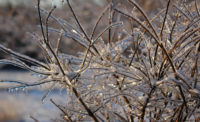When I was a kid I threw newspapers in the Texas Panhandle. Winters were cold, but the wind turned the cold into torturous conditions. Back in “the day” I was armed with tennis shoes that quickly got wet and only provide a weak substrate for the ice to attach. Gloves could only be used once the rubber bands were placed on the papers. By that time frost bite was looming.
Ok, Ok I never actually got frostbite, but always thought I would lose my toes and fingers to the winter storms.
This kind of agony simply isn’t necessary with today’s knowledge and equipment “IF” we equip our employees with the proper cold weather clothing, equipment and knowledge.
Be proactive
The first step in protecting of our employees with proper protective winter clothing is doing it before the need is there. Waiting until the weather man is pointing to the map of that first massive winter blizzard is not a good time to start considering what protective winter clothing, equipment and information your employees need.
Start with a job description based job safety analysis (JSA/JHA). (What a novice approach!) By approaching clothing needs from a job description perspective it will help you capture all of the protection needs and not just those needs for any single work day or storm event. This approach allows you to capture all work conditions such as work in elevated areas; work at or below grade; wet weather conditions; excessive exposure to wind; tasks that must be incorporated into other PPE such as level A-D suits or flame- resistant (FR) clothing; and other situations that make a straightforward protective winter clothing and equipment plan not so straightforward.
Engineering the hazard out of the equation from the start is another primary approach. You might very well say, “I can’t engineer the cold out.” That’s true to some degree, but look at it from these perspectives:
- Can temporary shelters or barriers lessen or eliminate the conditions?
- Can the task be done during hours more favorable such as in the warmest part of the day; before or after the worst weather impact; or split between shifts — limiting any one individual’s exposure time;
- Can the task be moved inside?
Think of these possible steps as making accommodations for your regular JSAs.
Be ready to improvise
Again, remembering my first petrochemical plant job in the Texas panhandle we learned that even unexpected repairs high in the structure need to incorporate tarps secured in the structure to block the unrelenting north wind. We found that not only were the employees warmer and less stressed, but the work was completed faster and the process back on line sooner when we accommodated the employees for cold weather.
Another simple gesture that employees really appreciated was laying down plywood over grating decking where they were working. This temporary layer also helped to shield from the wind and cold and kept the feet just a little warmer.
Dressing in layers
All of us have trained our employees that winter weather clothing is best handled by dressing in layers. Simple enough. But maybe our employees need a little more help than “dress in layers.” We owe it to our employees to give them not only more in-depth training on how to dress in layers, but we also should provide some of those fundamental “layers.” The easiest items are glove liners. They start around $2.00 and keep our employees’ primary means of doing work (their hands) warm and more functional. There are glove liners with even more protections for really severe situations.
Our organizations cannot accept that it is our responsibility to provide proper PPE to our employees under normal conditions and then send them out in harsh winter conditions that we know are too severe for that normal PPE. This would apply for all PPE not just gloves -- for example hard hat liners, safety vest and footwear. Approved and perfectly suited footwear in the summer may be the absolute worst for employee safety and comfort in the winter. A safety vest with breathable mesh in the summer can easily be replaced with a vest that will serve as another layer of warmth in the winter.
Clothing advances
The technology and availability of cold weather clothing has advanced from when I was a paper boy in the Texas Panhandle in the same way the Big Chief tablet has advanced to the cell phone and e-tablet. Vendors group products in categories such as Very Cold + Very Active; Cold + More Active; Very Cold + Less Active; and Cold + Less Active. Others vendors categorize by temperature at which the product can be expected to provide protection; 0o, -30o, -60o.
There is an excellent document that provides straightforward guidance on what each layer of protection should look like and what materials are best for each purpose for Extreme Cold Weather Clothing (ECW Clothing) at: http://www.usap.gov/travelAndDeployment/documents/FieldManual-Chapt1ExtremeColdWeatherClothing.pdf
The document, the “Field Manual - Extreme Cold Weather Clothing” is intended for those going into Antarctica conditions, but the underlying concepts are the same for keeping our employees protected in cold weather conditions in our own facilities and workplaces. It also covers basic principle of how to stay warm and get the most out of the clothing you are wearing.
More than temperature protection
It’s important to keep in mind that there is more to winter protective clothing than just the temperature protection. “Cold weather” encompasses weather conditions like rain, snow, and wind.
Exposure time is another critical factor. Going out to get the paper is much different than overhauling machinery or excavating out in the middle of nowhere.
Other factors that must be carefully considered are the amount of dexterity the employee will be using; is the work elevated; is the work in wet or contaminated environments; and will there be a place to get out of the elements in close proximity.
Don’t downplay exposures
Whether your employees will wear cold weather clothing day in and day out or whether it will be an isolated event is an important consideration, but also a common downfall of providing your employees with proper protection. If your employees are only going to do a cold weather task for a short time period it is often assumed that the employee doesn’t need all the gear and protection as someone that does it every day.
Think of the hazard more in the light of how we would address exposure to acid or other toxic material. Any harmful exposure is too much. This makes it even more important that we use engineering controls, JSA planning, training and other tools to ensure that every employee has the proper equipment and knowledge to weather the storm without being subjected to any undo hazards.


